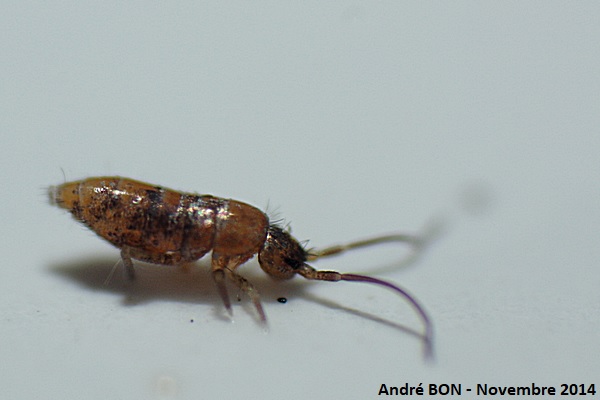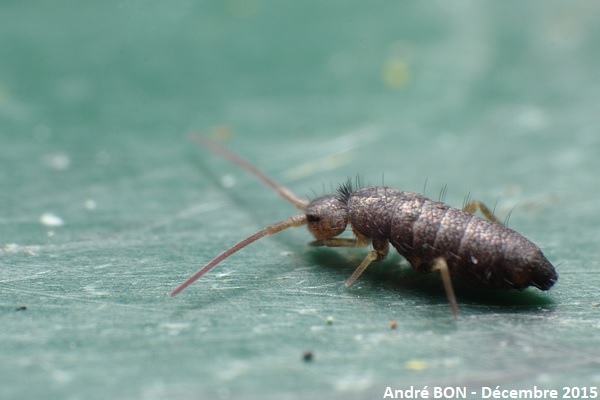

| Pogonognathellus flavescens (Tullberg, 1871) |


|
|
Scientific name: Pogonognathellus flavescens (Tullberg, 1871) Common name: French name: Phylum: Arthropoda Class: Collembola Order: Entomobryomorpha Family: Tomoceridae Size: 4-4,5 mm. Habitat: Damp and shady habitats, under stones or logs, among the litter. Food: Detritivorous, remains of plants. Reproduction: Males deposit spermatophores (small capsules containing spermatozoa and attached to the substrate by a small peduncle) which are then collected by the females. Geographic area: Holarctic region. |
Springtails of the Entomobryomorpha order show a thin and elongated body with segments of different sizes. Springtails of the Symphypleona order are round-shaped, almost spherical. Those of the Poduromorpha order show an oval body, with rounded segments which are all of similar size. There are five abdominal segments. The third one is longer on springtails of the Tomoceridae family. The fourth segment is the longer one on springtails of the Entomobryidae family. The rather long antennae have 4 articles (they are fragile and often broken). Article 3 is the longer one in the Tomoceridae family. Articles 3 and 4 become thinner towards the apex on springtails of the Pogonognathellus genus. They are almost cylindrical on springtails of the Tomocerus genus. Pogonognathellus flavescens shows an elongated body with antennae shorter than the body length. It is a general bluish grey colour but it can turn to orange yellow on specimens that have lost their scales. There is a collar of long black hairs just at the back of the head and some other sparse hairs on the body. Tomocerus minor is very similar and can be difficult to differentiate on picture if there is not a correct view of the antennae. There are other criteria but they require a binocular exam (empodium shorter than the claws at the tip of the legs as an example). Pogonognathellus longicornis has long antennae whose length significantly exceed the size of the body. |
| [To know more about the Pogonognathellus flavescens] [Next picture] [Top] |

|
The small size of these springtails makes it difficult to shoot pictures. In order to get a correct magnification I have used a 24mm lens, mounted the reverse way and with the aperture blocked at F/10. The depth of field is then very short and the picture is not very sharp. I am sure I will be able to do better in the future. However the picture is enough to see that the third abdominal segment and the third article of the antennae are the longer ones. This leads to the Tomoceridae family. The third article of the antennae seems to become thinner towards the apex. This leads to the Pogonognathellus genus. It is possible that this one is Pogonognathellus flavescens with antennae's length not exceeding the length of the body, but the picture is not sharp enough to conclude. So we will list this one as Pogonognathellus sp. |
| [To know more about the Pogonognathellus flavescens] [Previous picture] [Top] |

|
This is a better picture. The antenna becomes thinner and its length is less than that of the body. So I think that this one is Pogonognathellus flavescens. |